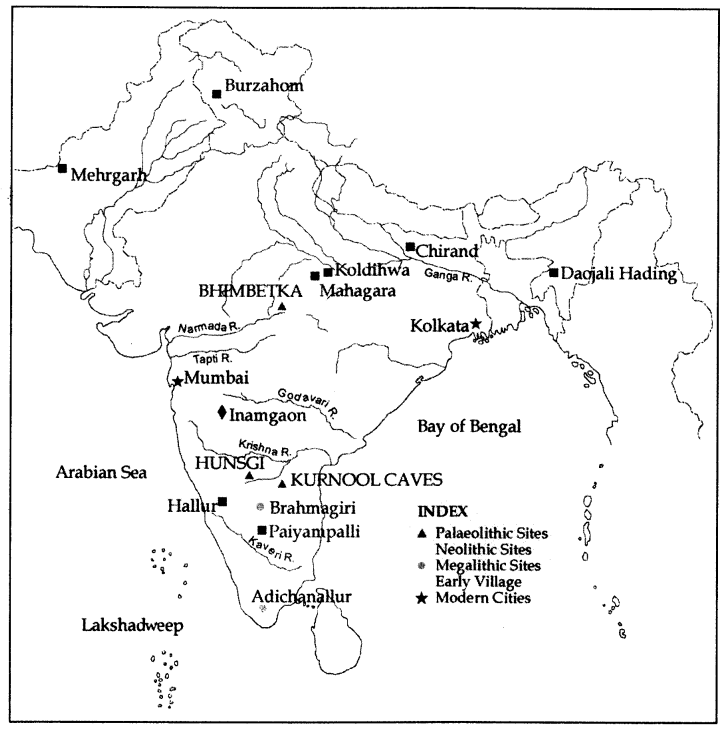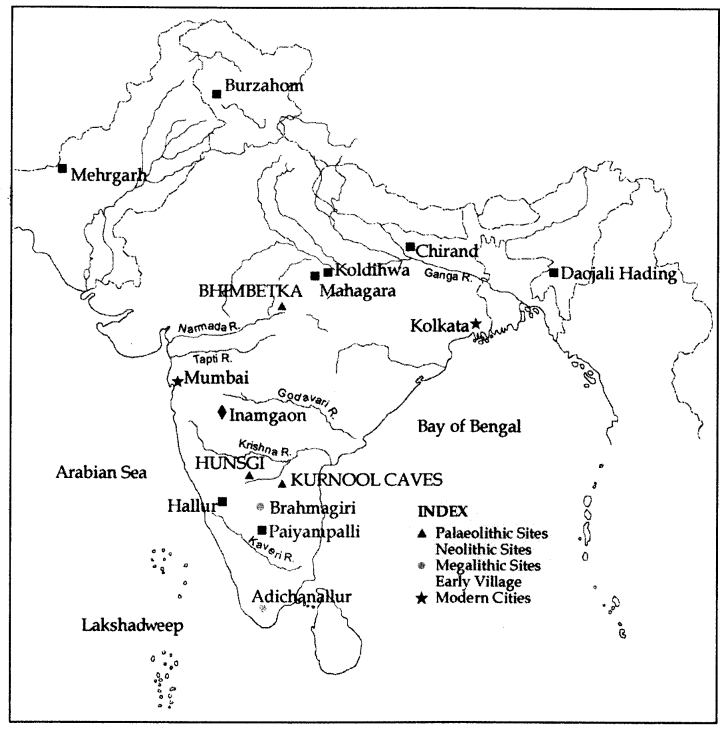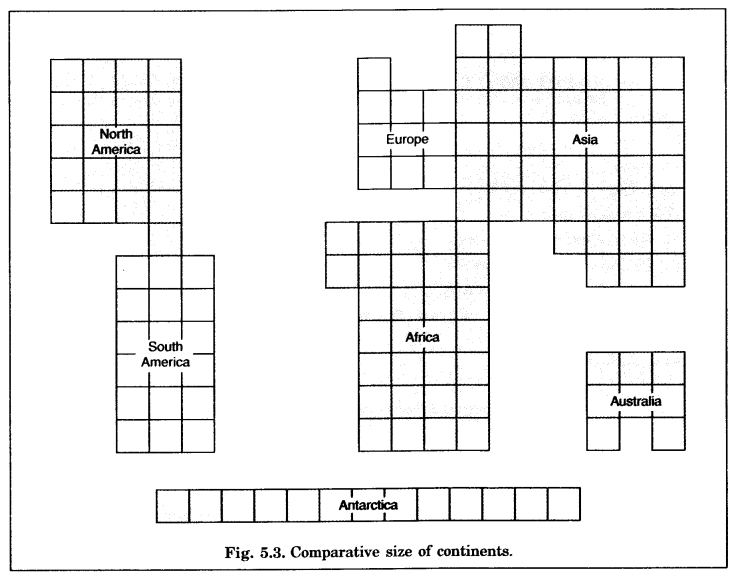NCERT Solutions for Class 6 Social Science Civics Chapter 7 Urban Administration are part of NCERT Solutions for Class 6 Social Science. Here we have given NCERT Solutions for Class 6 Social Science Civics Chapter 7 Urban Administration.
| Board | CBSE |
| Textbook | NCERT |
| Class | Class 6 |
| Subject | Social Science Civics |
| Chapter | Chapter 7 |
| Chapter Name | Urban Administration |
| Number of Questions Solved | 19 |
| Category | NCERT Solutions |
NCERT Solutions for Class 6 Social Science Civics Chapter 7 Urban Administration
NCERT TEXTBOOK QUESTIONS (Pages 63-64)
Question 1.
Why did the children go to Yasmin Khala’s house?
Answer:
The four children had broken the street light while playing a game of cricket. They wanted to know to whom should they give them money for the replacement of the light. Yasmin Khala has just retired from the Municipal Corporation and she may be knowing the answer.
Question 2.
List four ways in which the work of the Municipal Corporation affects the life of a city-dweller.
Answer:
The Municipal Corporation affects the life of a city-dweller in several ways:
- It takes care of street lights.
- It ensures that diseases do not break out in the city.
- It runs schools, hospitals, and dispensaries.
- It takes care of garbage collection, water supply, keeping the streets and the market clean.
Question 3.
Who is the Municipal Councillor?
Answer:
Municipal Councillors are the elected members of the Municipal Corporation. They are elected by the registered voters of the city for five years.
Question 4.
What did Gangabai do and why?
Answer:
Gangabai and other women of her locality were very much unhappy to find garbage lying all over the street and spreading foul smell. One day she said that it is the Ward Councillor who they should go to and protest since they are the ones who elected him. She gathered a small group of women and went to his house to get their problems solved.
Question 5.
How does the Municipal Corporation earn the money to do its work?
Answer:
Municipal Corporation earns money to do its work by collecting several types of taxes. They include:
- Property tax.
- Taxes for education and other amenities.
- Entertainment tax.
- Other taxes.
Photo 1:
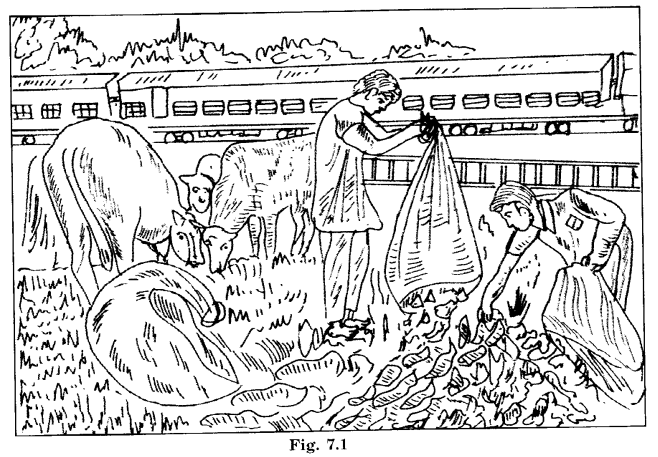
Photo 2:
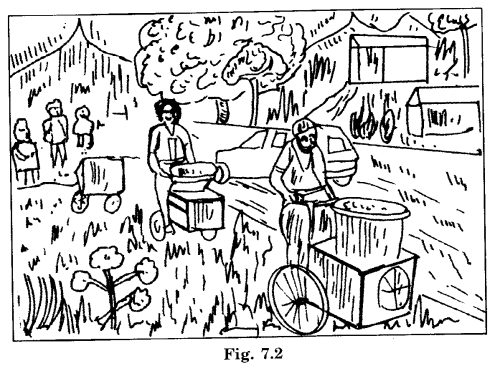
Question 6.
Discuss:
In the above two photographs (Fig. 7.1 and 7.2) you see different ways of collecting and disposing of garbage.
(i) Which way do you think provides safety to the person disposing of garbage?
(ii) What are the dangers of collecting garbage in the manner shown in the first photograph?
(iii) Why do you think that proper ways of disposing of garbage are not available to those who work in municipalities?
Answer:
(i) The second photograph shows people pushing a trolley full of garbage is segregated is a Safefui way of disposing of garbage.
(ii) The dangers of collecting garbage in the manner shown in the first photograph are:
- People are standing on the garbage heap and work with bare hands, they are exposed to all kinds of infections.
- The stay cows and other animals are trying to find food and they also pollute the land.
- The garbage is not segregated into degradable and non-degradable.
- Pieces of broken glass can pierce the hands of the workers and there is a possibility HIV germs may enter the bodies.
- The whole area is a filthy and polluted area which is a breeding ground for germs of all kinds of diseases.
(iii) The proper way of disposing of garbage are not available to those who work in the municipalities because:
- Municipal Corporation does not provide gumboots and gloves to the workers.
- The Corporation does not have garbage trucks that can automatically lift the garbage.
- The Corporation does not provide enough landfills where the garbage can/be dumped.
- The people are expected to segregate the degradable and non-degradable garbage, which is not done by them.
Question 7.
Several poor people in the city work as domestic servants as well as work for the Corporation, keeping the city clean. Yet the slums in which they live are quite filthy. This is because these slums seldom have any water and sanitation facilities. The reason often given by the Municipal Corporation is that the land in which the poor have set up their homes does not belong to them and that slum-dwellers do not pay taxes. However, people living in middle-class neighborhoods pay very little in taxes compared to the amount of money the corporation spends on them in setting up parks, street lighting facilities, regular garbage collection etc. Also as you read in this chapter, the property taxes collected by the Municipality makes up only 25-30 percent of its money.
Why do you think it is important that the Corporation should spend more money on slum localities? Why is it important that the Municipal Corporation provide the poor in the city with the same facilities that the rich get?
Answer:
- It is important that the corporation should spend more money on slum localities because the major workforce lives in these colonies. They work so hard that the economic activities of the city-run smoothly. Hence, adequate money should be spent on slum locations.
- It is also important that municipal corporation provides the poor in the city with the same facilities that the rich get because of the following reasons:
- God has sent both poor and rich as one and the same.
- Poor constitutes the major workforce. Health needs to be cared for.
- They must be hale and hearty.
INTEXT QUESTIONS
Question 1.
Have you ever wondered who is responsible for running all this (civic amenities)? (NCERT Page 57)
Answer:
Yes, we have ever wondered that these services are run by the urban administration.
Question 2.
Do you know how decisions are made? (NCERT Page 57)
Answer:
Yes, decisions are made by the urban administrative machinery.
Question 3.
How is the planning done? (NCERT Page 57)
Answer:
Planning is done by a set procedure.
Question 4.
Who are the people who do all these works? (NCERT Page 57)
Answer:
The people who do all these works are the officers, officials and the elected representatives of the civic body.
Question 5.
Read the following story and answer the questions that follow it:
One lazy Sunday afternoon Mala and her friends Shankar, Jehangir and Rehana were playing a game of cricket in the street.
Shankar had bowled a good over and although he nearly managed to get Rehana out, she was still batting. Frustrated, he bowled a short ball and hoped she would hit it for an easy catch. Instead, Rehana hit the ball so hard and so high that the street light broke.
Rehana screamed, “Oh no, look what I’ve done!” Shankar said, “Yes! we forgot to make a rule that if you break the street light you are automatically out.” But Mala, Jehangir and Rehana were more worried about what had happened and they told Shankar he’d better stop thinking about the wicket. Last week they had broken Nirmala Mausi’s window and had spent their pocket money to have it replaced.
- Would they have to dish out money again from their pockets?
- But who would they pay this to?
- To whom did the lights on the streets belong?
- Who changed them? (NCERT Page 57)
Answer:
- Yes, they would have to dish out money again from their pockets.
- But they would not pay this to any person, as there is no rule for the damage caused to light on the streets.
- The lights on the streets belong to the civic body (Municipal Corporation).
- The electricity department of the civic body changed them. In Pune it is the Municipal Corporation.
Question 6.
Rehana’s house was the closest and they ran and told her mother what had happened. Rehana’s mother said, “I don’t really know these things in great detail but I do know that it is the Municipal Corporation of the city that takes care of replacing lights. The best person to ask would be Yasmin Khala. She just retired from the Municipal Corporation. Go and ask her, and Rehana come back home soon.”
Yasmin Khala lived in the same lane and she and Rehana’s mother were good friends. The children ran to Khala’s house and when she opened the door they began to tell her what had happened all at once! When they asked about the street light, Yasmin Khala laughed and said, “There is no one person that you can pay the money to. There is a big organisation called the Municipal Corporation that takes care of street lights, garbage collection, water supply, keeping the streets and the market clean.”
“I’ve heard about the Municipal Corporation. They’ve put up signs around the city to inform people about Malaria,” said Mala.
“Yes, you are quite right. The Municipal Corporation is also responsible for ensuring that diseases do not break out in the city. It also runs schools, hospitals, and dispensaries. And makes gardens and maintains them,” said Yasmin Khala. Then she added, “Our city Pune is a big city and so here it is called a Municipal Corporation. In smaller towns, it is called a Municipal Council.”
List at least four different tasks that the Municipality does: (NCERT Pages 57-58)
Answer:
List of four different tasks that the Municipality does:
- Care of street lights, garbage collection, water supply, keeping the streets and markets clean.
- Eradication of malaria and taking care not to break out diseases.
- Running of schools, hospitals, and dispensaries.
- Making and maintenance of gardens and parks.
Question 7.
Fill in the blanks in the sentences below:
- In a panchayat, the elected members are called ………..
- The city is divided into several …….
- In a municipal corporation, the elected members are called …………
- Groups of councilors deal with issues that affect the ……….
- Elections are held once every ……….. year for the panchayat as well as for the municipality.
- While the councilors make decisions the administrative staff led by the Commissioner ……….. these. (NCERT Page 59)
Answer:
- Panch
- wards
- ward councilors
- entire city
- five
- Municipal Corporation, execute/implement.
Question 8.
Question Box: (NCERT Page 59)
How does the Municipal Corporation get its money?
Answer:
- Providing and running so many services requires a lot of money.
- The Municipal Corporation collects this in different ways:
- A tax is a sum of money that people pay to the government for the services the government provides.
- People who own homes have to pay a property tax as well as taxes for water/ sewerage and other services.
- The larger the house the more is the tax.
- Property taxes however form only 25-30 percent of the money that a Municipal Corporation earns.
- There are also taxes for education and other amenities.
- If you own a hotel or shop then you have to pay a tax for this as well.
- Also, you have to pay entertainment tax for seeing movies etc.
- A much wider population pays more general taxes.
Thus, money comes to the Municipal Corporation through various taxes.
- A tax is a sum of money that people pay to the government for the services the government provides.
Question 9.
Does a municipal corporation have a lot of workers?
Answer:
Yes, Municipal Corporation has several departments. Every department has numerous workers. These departments are:
- Water Department in the case of Delhi, Delhi Jal Board, though a separate autonomous body.
- Garbage Collection Department.
- Garden (Horticulture) Department.
- Roads Department (PWD).
- Sanitation Department.
Question 10.
Question Box: (NCERT Page 61)
What has changed since Khala retired?
Answer:
- In recent times, in order to save money, the Commissioners of several municipalities across the country had hired private contractors to collect and process garbage. This is called Sub-Contracting. This means that the work that was earlier being done by government workers is now being done by a private company.
- These contract workers get paid less and their jobs are temporary and casual.
- Collecting garbage is also quite a dangerous job and often these contract workers do not have any access to safety measures.
- They are not taken care of if they are injured while working.
Question 11.
Question Box: (NCERT Page 61)
- What was Gangabai protesting about?
- Why do you think Gangabai decided to approach the Ward Councillor?
- What did Gangabai say when the Commissioner said that there were not enough trucks in the city?
Answer:
- Gangabai was protesting against the lying of garbage all over the streets.
- Gangabai decided to approach the ward councillor to get his support for protesting against the unsanitary conditions in the locality.
- Gangabai said that the corporation had enough trucks to remove garbage from the colonies of the rich and not for the colonies of the poor and middle class. Hearing this, the commissioner became speechless.
Question 12.
An Event Box: (NCERT Page 61)
The city of Surat had a plague scare in 1994. Surat was one of the dirtiest cities in India. Houses, hotels and restaurants would dump their garbage into the nearest drain or street which made it very difficult for sweepers to collect and transfer the garbage into selected dumps. In addition to this, the Municipal Council did not collect the garbage as often as it should have and this led to the situation getting worse. The plague spreads through the air and people who have the disease have to he isolated. In Surat, several people lost their lives, and over 300,000 deserted the town. The scare of the plague ensured that the municipal council completely cleaned up the city. To this date, Surat continues to remain the second cleanest city in India after Chandigarh.
- Do you know when and how often garbage gets collected in your neighbourhood?
- Do you think it is the same for all neighbourhoods in the city? Why not? Discuss.
Answer:
- We know that
- Garbage gets collected early in the morning.
- It is collected through a mobile truck which goes on from house to house giving whistle.
- I think it is the same for all neighbourhoods in the city. It must be the same for r all localities.
We hope the NCERT Solutions for Class 6 Social Science Civics Chapter 7 Urban Administration helps you. If you have any query regarding NCERT Solutions for Class 6 Social Science Civics Chapter 7 Urban Administration, drop a comment below and we will get back to you at the earliest.
